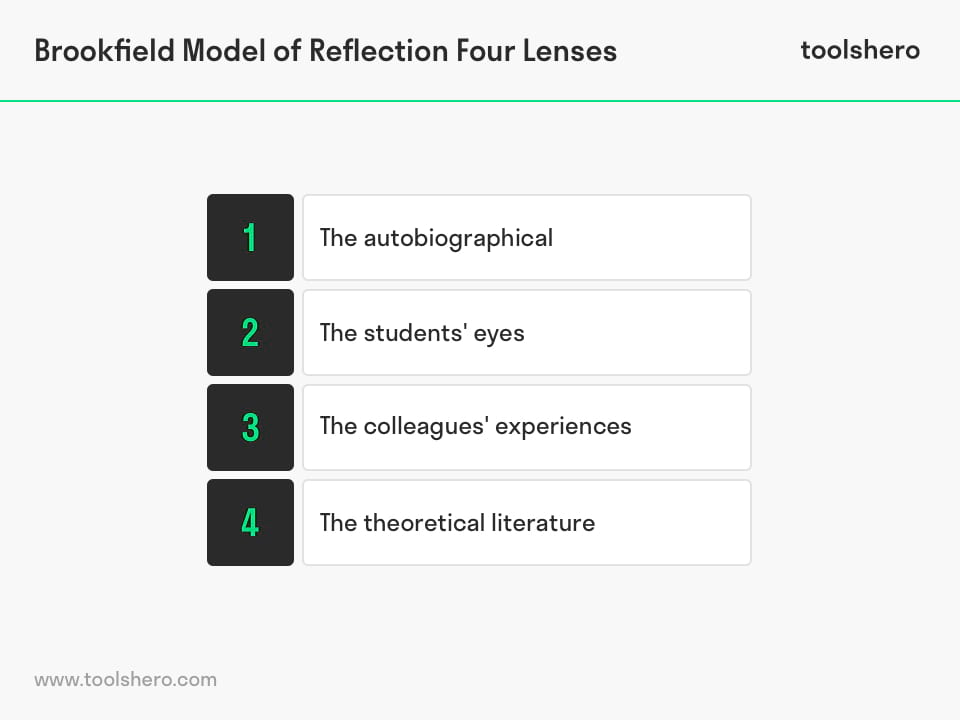Brookfield Model of Reflection

Brookfield Model of Reflection: this article provides a practical explanation of the Brookfield Model of Reflection After reading this article, you’ll understand the basics of this powerful reflection tool to improve learning skills and critical self-reflection.
What is the Brookfield Model of Reflection?
The Brookfield Model of Reflection is a tool that helps teachers discover the value of their lessons through critical self-reflection. Brookfield indicates that critically reflective teachers make excellent teachers that are able to convey their own voice to others in an authentic way.
When teachers reflect more and better, they are better able to reliably and accurately judge the approach of education, evaluation, planning and design of learning plans and assessments and handle students’ problems. It is therefore crucial to carry out these responsibilities with a critical evaluation from as many different perspectives as possible.
Many schools encourage teachers to think critically about their own teaching methods and students’ learning by means of the four different, mutually connected lenses of Stephen Brookfield. These four lenses are used for critical self-reflection, aimed at developing a critically reflective teacher.
Who developed the Brookfield Model of Reflection?
The Brookfield Model of Reflection was developed by Stephen Brookfield in 1995. During his teaching career, Brookfield taught in several different countries.
Among the countries he has taught in are the United States, England, and Canada. During his career, Brookfield wrote 19 books. The subjects of these books range from critical thinking, methods of discussion, critical theory to learning races. His goal has always been to help adults think critically about the dominant ideas each person has internalised.
Brookfield Model of Reflection: four lenses
According to Brookfield, critically reflective teachers create three advantages:
- Inspiring self-confidence
- Achieving educational SMART goals
- Motivated, critically reflective students
The goal of the critically reflective teacher is to gain higher awareness of his or her own teaching from as many perspectives as possible. For this purpose, Stephen Brookfield has developed the four lenses in the Brookfield model of reflection. These can be used by teachers in the process of critical reflection. This concerns the following four lenses, or perspectives:
- The autobiographical lens
- The student’s eyes
- Colleagues’ experiences
- The theoretical literature
These lenses correlate to the processes of self-reflection, feedback, peer review and consultation of scientific literature. By continuously improving these processes, a foundation is built for better education and the tools to become a good teacher.
1. The autobiographical lens
This is the first lens of the Brookfield Model of Reflection and is also where a teacher can uncover pedagogical aspects that must be strengthened or adjusted.
The autobiographical lens helps teachers to consider their own experiences with students concerning education and learning. The analysis of this learning experience will help to uncover assumptions and convictions about how people learn.
Aspects of their pedagogy can be revealed through learning books, evaluations, student feedback, personal results, or other techniques. Self-reflection is the basis of reflective teaching.
Activities within the autobiographical perspective
- Philosophy of teaching and learning
- Recordings
- Teaching logs
- Audits
- Advice
2. The student’s eyes
It is necessary to go beyond reflection through the autobiographical lens. According to the Brookfield Model of Reflection, it is essential that teachers understand students’ experiences.
Teachers can do this through evaluations with students about teaching styles, test methods, focus groups or interviews. This will make their teaching more responsive.
The student lens also reveals whether any existing assumptions about power relationships must be adjusted, as well as students’ learning habits through feedback.
Activities student’s perspective
- Formal evaluations
- In-class evaluations
- Focus groups
- Interviews
- Letters
- Questionnaires
3. Colleagues’ experiences
Good teachers are focused on the first two lenses, but excellent teachers will also intensively work with these processes and engage with colleagues regarding mentoring, advice, and feedback.
Additionally, teachers can increase their confidence through contact with other teachers. This is because they discover that they are not alone in making peculiar mistakes, and that this is an experience shared with their peers.
And to exchange experiences in the field of working in teams, participating in seminars, workshops, peer reviews, or thinking about educational theories and methods.
Activities colleagues’ experiences
- Learning circles
- Collaborative problem solving
- Critical conversations and evaluations
4. The theoretical literature
The fourth and final lens of the Brookfield Model of Reflection for critical reflection in education concerns the scholarly literature about higher education.
Teachers who explore, present or publish this literature have an advanced vocabulary and plenty of methods for their teaching practices. An engagement with both the scientific literature and colleagues supports teachers.
Activities theoretical literature
- Conferences
- Professional journals
- Research
Complete Personal Development and Transformation Course
Tips for introducing critical reflection in education
As a teacher, it is sometimes difficult to apply new methods or techniques while teaching. Use the step-by-step plan below to encourage critical reflection in students.
Tip 1: appeal to their curiosity
When students must learn new concepts or subjects, they often experience a feeling uncertainty and imbalance if they don’t immediately understand the new information.
Critical reflection is needed to assess new information and solve the imbalance. This requires a lot of time and energy. Rousing students’ curiosity can motivate them to engage in the reflective process.
Providing the right activities and asking the right questions could help to rouse their curiosity.
Tip 2: make reflection continuous
Integrate periodic, structured possibilities for learning to reflect. Because critical reflection is a defined way of thinking, the students must have sufficient opportunities to give and receive feedback.
Various activities can be used to advance reflection, including: writing exercises, problem-solving exercises, role play, discussions and simulations.
Working in groups is also an important activity to promote reflection. To be effective, the activity must be linked to learning results of a course or programme.
Tip 3: provide the right context for reflection
To support the integration of learning in courses, it’s important to involve students in big questions related to public or communal issues that are active outside the classroom.
This is where the Brookfield Model of Reflection can make a difference. Reflective activities then encourage students to identify and consider messy, poorly defined problems that don’t have a right answer or approach. This helps to shape them to a higher order of thought and reflection levels.
Tip 4: model the reflective process
By organising and modelling the feedback or reflection process by asking the type of questions that specifically match a discipline.
Indicate how a claim is supported by evidence and during the process, explain how the reflective practice process is modelled. By giving students a part, they can also practice the process.
Tip 5: encourage evaluation from different perspectives
Being exposed to different perspectives is crucial for the reflective thinking process. This can be achieved through discussions with classmates, lectures, websites, simulations or case studies.
These each represent different points of view and are able to engage in dialogue with others about crucial matters. Students can work on by carrying out collaboration projects.
The usefulness of critical thinking
There’s no one who can think critically at all times. Sometimes, our thoughts are influenced by anger, sadness or joy.
On the other hand, there is the possibility to increase the current critical thinking by carrying out certain routine-based activities for problems in everyday life. This is the goal of the Brookfield model of reflection. Try out the following simple exercise.
Critical thinking exercise
Think of something someone has recently told you. This might be a random piece of information, gossip or a story. Then ask yourself the following questions:
- Who said it?
- Someone you know?
- Someone with a certain level of authority?
- Does it matter who shared the information?
- What was said?
- Were facts included?
- Or opinions?
- Was something left out in the story?
- Where was this said?
- Was it in public?
- Or was it in private?
- Did the person in question had the opportunity to respond? Or to deny it?
- Why did they say it?
- Is someone trying to come off better in the story?
- Was the reasoning behind their opinion shared?
- Did someone try to stick up for someone else?
- How was it said?
- Was this person happy or sad? Angry or indifferent?
- Was it written or spoken?
- Can you understand what was said?
The skills needed for critical thinking and critical evaluation are varied and encompass analyses, interpretations, reflections, observations, explanation, and problem solving, as well as decision making. Teachers must at least be able to:
- Objectively and critically look at a subject or a problem
- Identify different arguments related to a certain problem
- Recognise weak or negative points in evidence and arguments
- Evaluate points of view to determine how valid these are
- Give a structured reasoning and support of the argument being made
- Notice which implications or problems may be involved in an explanation or argument
The Stephen Brookfield Critical Incident Survey
During his teaching career, Brookfield asked his students to fill out a questionnaire every week. The answers that are given form a central part of the feedback a critically reflective teacher continuously receives.
The questionnaire takes up about five minutes of the students’ time. The questionnaires must be filled out anonymously. So, make sure they don’t write down their names.
At the end of the next class, Brookfield discussed the answers with the group. It’s important to actively thank the students for their participation.
After all, they form one of the most important links in the improvement process of teachers. The questionnaire is therefore a crucial part of the Brookfield model of reflection.
The following questions are included in the Stephen Brookfield Critical Incident Survey:
- At what moment during the class or during which lessons did you feel most involved in what was going on?
- At what moment during the class or during which lessons did you feel furthest removed from what was discussed or what was happening?
- What action, whether carried out by a teacher or fellow student, was most useful and appropriate?
- What action, whether carried out by a teacher or fellow student, was most confusing or confounding?
- What part of the lesson materials surprised you most this week?
Brookfield Model of Reflection: reflective teaching
The subject of the Brookfield Model of Reflection is reflective teaching. This reflective process is a cycle that must be repeated to improve teaching. In short, this reflective process consists of the following steps:
- Teaching
- Assessing the effect of teaching on students’ learning
- Considering new methods that could improve the quality
- Repeat the process
Reflection is a systematic assessment process that can be used by all teachers. It’s also a fundamental element of the Brookfield model of reflection and should be a part of every teacher’s toolbox.
The Brookfield Model of Reflection encourages working with others, because others are relied on for feedback and support. Eventually, reflection in the teacher will boost the students’ learning process. Everything is eventually tuned to them.
Now it’s your turn
What do you think? Do you recognise the explanation of the Brookfield Model of Reflection? Is critical reflection applied in the educational system you are/were active in? Do you think many teachers cling to their old teaching methods? And that a radical change is needed in the teaching method? Or do you believe that the old methods are more effective than the new and seemingly controversial methods?
Share your experience and knowledge in the comments box below.
More information
- Brookfield, S. (1992). Uncovering assumptions: The key to reflective practice. Adult Learning, 3(4), 13-18.
- Brookfield, S. (1998). Critically reflective practice. Journal of Continuing Education in the Health Professions, 18(4), 197-205.
- Brookfield, S. D. (2000). The concept of critically reflective practice. Handbook of adult and continuing education, 33-49.
How to cite this article:
Janse, B. (2020). Brookfield Model of Reflection. Retrieved [insert date] from toolshero: https://www.toolshero.com/personal-development/brookfield-model-of-reflection/
Published on: 07/31/2020 | Last update: 01/02/2024
Add a link to this page on your website:
<a href=”https://www.toolshero.com/personal-development/brookfield-model-of-reflection/”>toolshero: Brookfield Model of Reflection</a>













